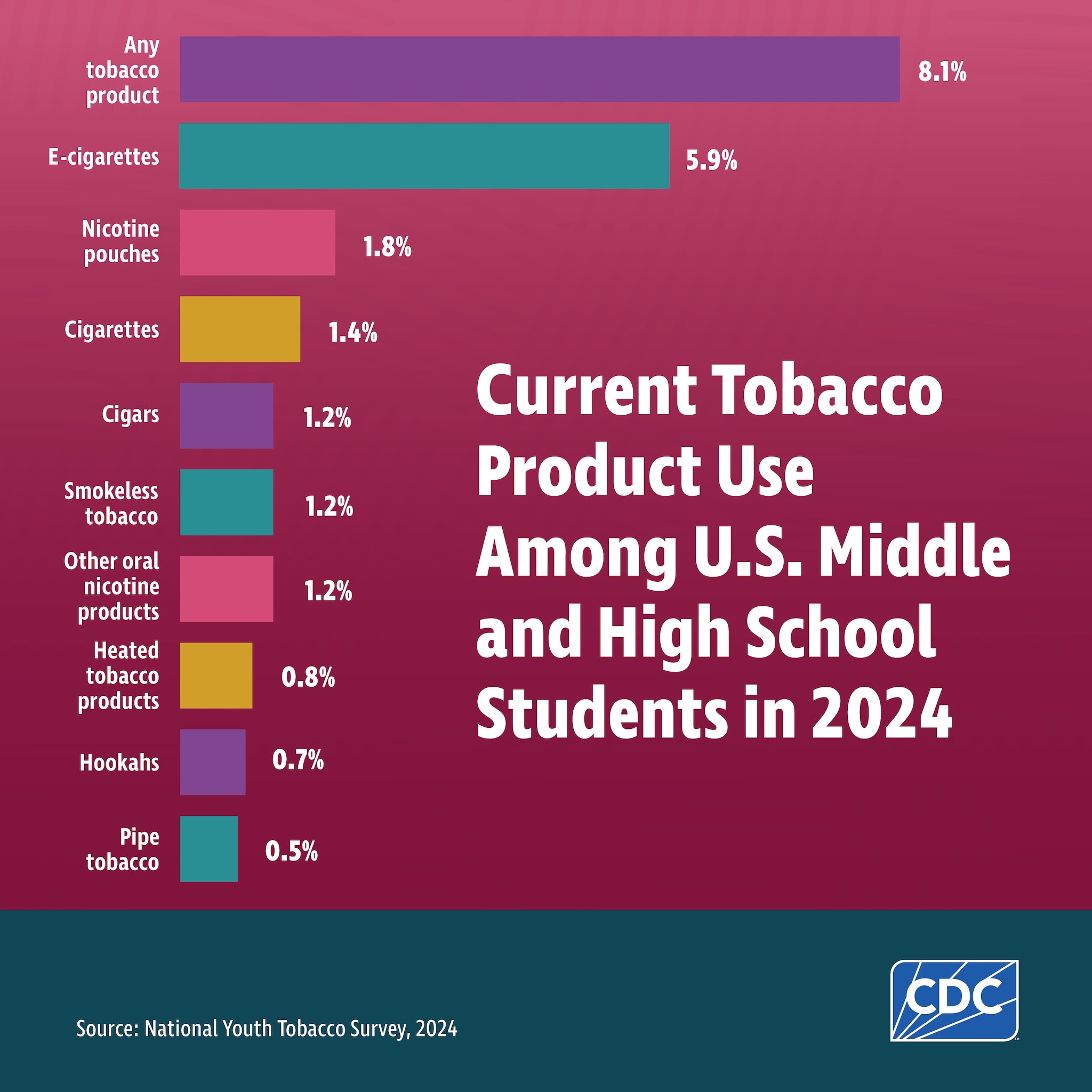What to know
- Use of tobacco products, in any form, is unsafe.
- Preventing tobacco product use among youth is critical to reducing tobacco use into adulthood.
- Review the data about youth tobacco use by product type.

Overview
Tobacco products, in any form, are unsafe. This is especially true for children, teens, and young adults. Tobacco products contain nicotine, which is highly addictive and can harm the developing brain.1
Preventing tobacco product use among youth is critical to reducing tobacco use among the nation's youth.
- Tobacco product use is started and established primarily during adolescence.23
- Nearly 9 out of 10 adults who smoke cigarettes daily first try smoking by age 18.
- In 2024, approximately two in five students who had ever used a tobacco product currently used them.4
- Flavorings in tobacco products can make them more appealing to youth.56 In the United States in 2024:
- 88.2% of high school students and 85.7% of middle school students who used e-cigarettes in the past 30 days reported using a flavored e-cigarette during that time.7
- 86.1% of high school students and 85.4% of middle school students who used nicotine pouches in the past 30 days reported using flavored pouches during that time.7
- 88.2% of high school students and 85.7% of middle school students who used e-cigarettes in the past 30 days reported using a flavored e-cigarette during that time.7
Estimates of current tobacco use among youth

Electronic cigarettes (E-cigarettes)
- E-cigarettes have been the most commonly used tobacco product among youth since 2014.
- In 2024, 1 out of every 29 middle school students (3.5%) reported that they had used electronic cigarettes in the past 30 days.7
- In 2024, 1 of every 13 high school students (7.8%) reported that they had used electronic cigarettes in the past 30 days.7
Nicotine pouches
- In 2024, 1 of every 100 middle school students (1.0%) and 1 of every 42 high school students (2.4%) reported using nicotine pouches in the past 30 days.7
- Nicotine pouches are microfiber pouches with flavored nicotine powder that users dissolve in the mouth without spitting. Sales of nicotine pouches have increased rapidly in the U.S.8
Cigarettes
- In 2024, 1 of every 91 middle school students (1.1%) reported that they had smoked cigarettes in the past 30 days.4
- In 2024, nearly 1 of every 59 high school students (1.7%) reported that they had smoked cigarettes in the past 30 days.4
Cigars
- In 2024, 1 of every 125 middle school students (0.8%) reported that they had smoked cigars in the past 30 days.4
- In 2024, 1 of every 67 high school students (1.5%) reported that they had smoked cigars in the past 30 days.4
Smokeless tobacco
- In 2024, 1 of every 125 middle school students (0.8%) reported that they had had used smokeless tobacco in the past 30 days.4
- In 2024, 1 of every 67 high school students (1.5%) reported that they had had used smokeless tobacco in the past 30 days.4
Heated tobacco products
- In 2024, 1 of every 143 middle school students (0.7%) and 1 of every 111 high school students (0.9%) reported using heated tobacco products in the past 30 days.4
- Heated tobacco products, also known as "heat-not-burn" products, deliver nicotine to the user by heating tobacco leaves rather than a nicotine-containing liquid like e-cigarettes.
Hookah
- In 2024, 1 of every 167 middle school students (0.6%) reported that they had smoked hookah in the past 30 days.4
- In 2024, 1 of every 125 high school students (0.8%) reported that they had smoked hookah in the past 30 days.4
All tobacco product use
- In 2024, 1 of every 19 middle school students (5.4%) and 1 of every 10 high school students (10.1%) reported current use of a tobacco product.4
- In 2024, 1 of every 8 middle school students (12.9%) and nearly 1 of every 4 high school students (23.6%) said they had ever tried a tobacco product.4
Many young people use multiple tobacco products.
- In 2024, 1 of every 48 middle school students (2.1%) and 1 of every 27 high school students (3.7%) reported current use of multiple tobacco products in the past 30 days.4
- In 2024, 1 of every 19 middle school students (5.4%) and 1 of every 9 high school students (10.9%) reported they had ever tried multiple tobacco products.4
Current Tobacco Product Use* Among High School Students in 20244
| Tobacco Product | Overall | Girls | Boys |
|---|---|---|---|
| Any tobacco product† | 10.1% | 9.3% | 10.9% |
| Electronic cigarettes | 7.8% | 7.7% | 7.8% |
| Nicotine Pouches | 2.4% | 0.8 | 3.9% |
| Cigarettes | 1.7% | 1.1% | 2.2% |
| Cigars | 1.5% | 1.0% | 2.1% |
| Smokeless tobacco | 1.5% | 0.6% | 2.3% |
| Other oral nicotine products§ | 1.4% | 0.9% | 2.0% |
| Heated tobacco products | 0.9% | 0.7% | 1.0% |
| Hookah | 0.8% | 0.7% | 0.9% |
| Pipe tobacco | 0.5% | 0.4% | 0.6% |
Notes:
*"Current use" is determined by respondents indicating that they have used a tobacco product on at least 1 day during the past 30 days.
†In 2024, any tobacco product included e-cigarettes, cigarettes, cigars, smokeless tobacco (composite), pipe tobacco, bidis (small brown cigarettes wrapped in a leaf), hookahs, heated tobacco products, nicotine pouches, and other oral nicotine products.
§Other oral nicotine products includes lozenges, discs, tablets, gums, dissolvable tobacco products, and other products.
Current Tobacco Product Use* Among Middle School Students in 20244
| Tobacco Product | Overall | Girls | Boys |
|---|---|---|---|
| Any tobacco product† | 5.4% | 5.5% | 5.3% |
| Electronic cigarettes | 3.5% | 3.9% | 3.1% |
| Nicotine Pouches | 1.0% | 0.9% | 1.1% |
| Cigarettes | 1.1% | 1.2% | 0.9% |
| Cigars | 0.8% | 0.8% | 0.7% |
| Smokeless tobacco | 0.8% | 0.7% | 1.0% |
| Other oral nicotine products§ | 0.9% | 0.9% | 0.8% |
| Heated tobacco products | 0.7% | 0.7% | 0.8% |
| Hookah | 0.6% | 0.7% | 0.4% |
| Pipe tobacco | 0.5% | 0.4% | 0.5% |
Notes:
*"Current use" is determined by respondents indicating that they have used a tobacco product on at least 1 day during the past 30 days.
†In 2024, any tobacco product included e-cigarettes, cigars, cigarettes, smokeless tobacco (chewing tobacco, snuff, dip, or snus), hookah, nicotine pouches, heated tobacco products, pipe tobacco, bidis (small brown cigarettes wrapped in a leaf), or other oral nicotine products.
§Other oral nicotine products includes lozenges, discs, tablets, gums, dissolvable tobacco products, and other products.
Factors associated with youth tobacco product use
Factors associated with youth tobacco product use include the following:
- Social and physical environments3910
- The way mass media show tobacco product use as a normal activity can make young people want to try these products.
- Youth are more likely to use tobacco products if they see people their age using these products.
- High school athletes are more likely to use smokeless tobacco than those of the same age who are not athletes.10
- Young people may be more likely to use tobacco products if a parent uses these products.
- The way mass media show tobacco product use as a normal activity can make young people want to try these products.
- Biological and genetic factors239
- There is evidence that youth may be sensitive to nicotine and that teens can feel dependent on nicotine sooner than adults.
- Genetic factors may make quitting smoking harder for young people.
- Smoking during pregnancy may increase the likelihood that the child will smoke cigarettes regularly in the future.
- There is evidence that youth may be sensitive to nicotine and that teens can feel dependent on nicotine sooner than adults.
- Mental health: There is a strong relationship between youth smoking and depression, anxiety, and stress.3
- Personal views: When young people expect positive things from smoking, such as coping with stress better or losing weight, they are more likely to smoke.39
- Other influences that affect youth tobacco use include:39
- Lower socioeconomic status, including lower income or education
- Not knowing how to say "no" to tobacco product use
- Lack of support or involvement from parents
- Accessibility, availability, and price of tobacco products
- Doing poorly in school
- Low self-image or self-esteem
- Seeing tobacco product advertising in stores, on television, the Internet, in movies, or in magazines and newspapers
- Lower socioeconomic status, including lower income or education

Reducing youth tobacco product use
National, state, and local program activities have been shown to reduce and prevent youth tobacco product use when implemented together.31112 These activities include:
- Enacting higher costs for tobacco products (for example, through increased taxes)312
- Prohibiting smoking in indoor areas of workplaces and public places312
- Raising the minimum age of sale for tobacco products to 21 years311
- Using TV and radio commercials, posters, and other media messages aimed at kids and teens in order to counter tobacco product ads312
- Engaging community programs and school and college policies that encourage tobacco-free places and lifestyles311
- Developing community programs that lower tobacco advertising, promotions, and help make tobacco products less easily available312
Some social and environmental factors are related to lower smoking levels among youth. Among these are:3
- Being part of a religious group or tradition
- Racial/ethnic pride and strong racial identity
- Higher academic achievement
It is important to keep working to prevent and reduce the use of all forms of tobacco product use among youth.
- U.S. Department of Health and Human Services. E-cigarette Use Among Youth and Young Adults: A Report of the Surgeon General. Centers for Disease Control and Prevention; 2016.
- U.S. Department of Health and Human Services. The Health Consequences of Smoking—50 Years of Progress: A Report of the Surgeon General. Centers for Disease Control and Prevention, U.S. Dept of Health and Human Services; 2014.
- U.S. Department of Health and Human Services. Preventing Tobacco Use Among Youth and Young Adults: A Report of the Surgeon General. Centers for Disease Control and Prevention, U.S. Dept of Health and Human Services; 2012.
- Jamal A, Park-Lee, E, Birdsey J, et al. Tobacco product use among middle and high school students — National Youth Tobacco Survey, United States. MMWR Morb Mortal Wkly Rep. 2024;73(41):917–924.
- Corey CG, Ambrose BK, Apelberg BJ, King BA. Flavored tobacco product use among middle and high school students — United States, 2014. MMWR Morb Mortal Wkly Rep 2015;64(38):1066–1070.
- Wang TW, Gentzke AS, Neff LJ, et al. Characteristics of e-cigarette use behaviors among US Youth, 2020. JAMA Netw Open. 2021;4(6):e2111336.
- Park-Lee E, Jamal A, Cowan H, et al. Notes from the field: e-cigarette and nicotine pouch use among middle and high school students—United States, 2024. MMWR Morb Mortal Wkly Rep. 2024;73(35):774-778.
- Gentzke AS, Wang TW, Jamal A, et al. Tobacco product use among middle and high school students — United States, 2020. MMWR Morb Mortal Wkly Rep. 2020;69(50);1881–1888.
- U.S. Department of Health and Human Services. Reducing Tobacco Use: A Report of the Surgeon General. Centers for Disease Control and Prevention, U.S. Dept of Health and Human Services; 2000.
- Agaku IT, Singh T, Jones SE, et al. Combustible and smokeless tobacco use among high school athletes — United States, 2001–2013. MMWR Morb Mortal Wkly Rep. 2015;64(34):935–939.
- Gentzke AS, Glover-Kudon R, Tynan M, Jamal A. Adults' attitudes toward raising the minimum age of sale for tobacco products to 21 years, United States, 2014-2017. Prev Med. 2020;133:106012. Epub ahead of print.
- Centers for Disease Control and Prevention. Best Practices for Comprehensive Tobacco Control Programs—2014. U.S. Dept of Health and Human Services; 2014.
- Substance Abuse and Mental Health Services Administration. 2018 National Survey on Drug Use and Health: Detailed Tables. Substance Abuse and Mental Health Data Archive. Accessed Dec 4, 2019. https://www.samhsa.gov/data/report/2018-nsduh-annual-national-report
- Gentzke AS, Wang TW, Cornelius M, et al. Tobacco product use and associated factors among middle and high school students — National Youth Tobacco Survey, United States, 2021. MMWR Morb Mortal Wkly Rep. 2022; 71(No. SS-5):1–29.
- Marynak KL, Wang X, Borowiecki M, et al. Nicotine pouch unit sales in the US, 2016-2020. JAMA. 2021;326(6):566–568.
